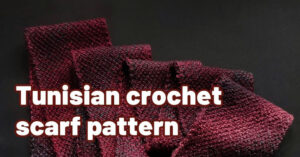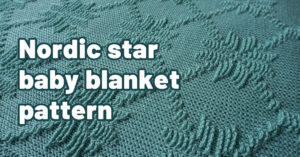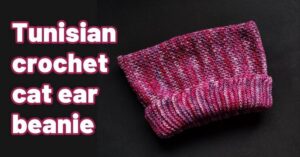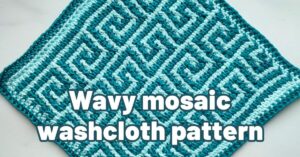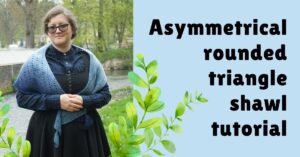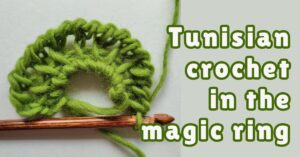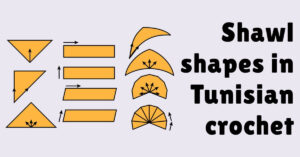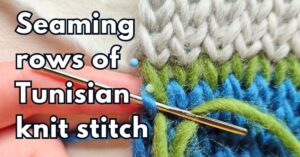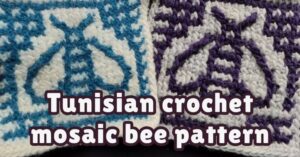How do you start a Tunisian crochet project? You need to start with foundation rows in Tunisian crochet, which can be made in many ways.
In this article I show you 4 ways of beginning a Tunisian crochet project when you need to make a foundation row.
If you want to learn how to make Tunisian crochet in the magic ring, I have a separate video tutorial for you.
Contents
Video tutorials on foundation rows in Tunisian crochet
Let’s start with the video tutorial that you can follow along with.
There are two videos, one for right handed and one for left handed crocheters. Choose the one you need based on the hand holding the hook.
Right handed video
Left handed video
First type of foundation row – working into a chain
This is the easiest method and the one that creates the most consistent results, as long as you have good tension when making chains.
You will either use a larger hook than the one needed to make your project or you will chain loosely.
The number of chains depends on the pattern and on the pattern writer. Some designers like to skip the first chain, some don’t (that’s me).
Make a slip knot and place it on the hook.
If you skip a chain, then chain as many times as many loops you need to have at the end of the forward pass. Otherwise, chain one less.
Start picking up loops in the back bumps of the chains, one in every chain. If skipping a chain, skip the one closest to the hook.
When you reach the last chain, pick up a loop in it (don’t pick up a loop in the slip knot) and chain 1. Then repeat the instruction “yarn over and pull through 2 loops on the hook” until you are left with 1 loop on the hook.
This is your foundation row and anything you make on top of it will influence how this row looks. For example, if you start a honeycomb pattern or if you make reverse stitches, these will show up in the foundation row.
Second type of foundation row
This is similar in construction with the foundation single crochet from regular crochet, except you don’t finish the stitches and leave one loop from each stitch on the hook.
This foundation row is taller than the previous one and it creates a non-curling border at the bottom of the fabric. It is also slightly more elastic than the previous method, but also much thicker.
You begin with a slip knot on the hook.
Chain 2, then insert the hook into the second chain from hook. Pick up a loop.
Chain 2 and repeat this process, inserting the hook in the second chain from the hook, picking up a loop.
Stop when you reach the required number of loops required by your pattern. The first loop on the hook will be the first stitch and the last loop will be the last stitch.
Chain 1, then repeat “yarn over and pull through 2 loops on the hook” until you are left with 1 loop on the hook.
The completed foundation row will retain some height, while the top loops will be affected by subsequent rows, just like with the first method.
Third type of foundation row – long tail cast on around the hook
For this method, you need a to prepare a long tail before you start casting on.
Loop the yarn around the hook as many times as you need loops at the end of the forward pass of the foundation row. Add about 20 cm of yarn that will be the tail left over.
Make a slip knot in the yarn where you finished looping and unravel the loops from the hook.
Put the slip knot on the hook and pick up the tail.
Place the tail over the hook from front to back, but in front of the working yarn. Hold on to the tail, while you pick up the working yarn with the hook and you pull a loop through the loop made by the tail.
Repeat this process until you reach the required loop count from your pattern. The first loop on the hook will be the first stitch and the last loop will be the last stitch.
Continue working only with the working yarn. The tail will be left aside to be woven in.
Chain 1, then repeat “yarn over and pull through 2 loops on the hook” until you are left with 1 loop on the hook.
Once the return pass is complete, your foundation row is ready. The vertical bars of the foundation row are now available for working any kind of Tunisian crochet stitch into them.
Keep in mind that you need to work with relaxed tension. The foundation row will be narrower than the rest of your project because the cast on is elastic.
Fourth type of foundation row – long tail cast on like in knitting
This method is the one I use when knitting and that I learned from my mother as a child. There are two ways of holding the yarn and two different movements of the hook.
You can choose just one of them, or use them together to make pairs of stitches that are easy to count.
This cast on is also elastic, so you can choose it for the same projects you’d use the previous cast on for. Anything that needs an edge that tends to pull in, like wrist cuffs, beanie edges, etc.
For this method, you also need a to prepare a long tail before you start casting on.
Loop the yarn around the hook as many times as you need loops at the end of the forward pass of the foundation row. Add about 20 cm of yarn that will be the tail left over.
Make a slip knot in the yarn where you finished looping and unravel the loops from the hook.
Put the slip knot on the hook and pick up the tail. You can also twist the yarn and put that loop on the hook if you don’t want a slip knot.
Wrap the working yarn around your index finger, from front to back, catching the rest in your palm.
Do the same with the tail around your thumb, with the yarn going from the needle and around your thumb, then into the palm.
The hook will end up in the middle of the space between thumb and index finger.
Depending on how you wrap the yarn around your thumb, you have two options.
Option 1. The tail comes from under the thumb, over the thumb and into the palm.
Insert the hook under the tail that goes into the hand and pick up the working yarn coming from the index finger, between the hook and the finger.
Bring this loop through the loop on the thumb and let go of the thumb loop, then use the thumb to pull on the tail to tighten the stitch.
Reposition the thumb and repeat this process. This creates stitches on the bottom that lean one way.
Option 2. The tail comes from behind the thumb, from top to bottom around the thumb and into the palm.
This creates a closed loop around the hand.
Go with the hook under the bottom of this loop around the thumb, inserting the hook through the loop and pick up the working yarn that comes from the index finger, pulling it through the loop on the thumb.
Release the loop on the hook and grab the tail. Pull it to close the loop on the hook.
Repeat this stitch as many times as needed.
If you want cute pairs of stitches, repeat Option 2 and Option 1 as many times as needed.
Repeat this process until you reach the required loop count from your pattern. The first loop on the hook will be the first stitch and the last loop will be the last stitch.
Continue working only with the working yarn. The tail will be left aside to be woven in.
Chain 1, then repeat “yarn over and pull through 2 loops on the hook” until you are left with 1 loop on the hook.
Once the return pass is complete, your foundation row is ready. The vertical bars of the foundation row are now available for working any kind of Tunisian crochet stitch into them.
The foundation row will be narrower than the rest of your project because the cast on is elastic.
Final remarks
I hope this article has been useful to teach you how to begin Tunisian crochet projects.
If you want to learn more about Tunisian crochet techniques and to explore some free patterns on the blog, check them out:
Corner to corner Tunisian crochet scarf pattern
Nordic star Tunisian crochet baby blanket pattern
Tunisian crochet cat ear beanie free pattern
Free wavy mosaic Tunisian crochet pattern
Feather and fan Tunisian crochet pattern for a washcloth
Tunisian crochet asymmetrical rounded triangle shawl tutorial
How to start a Tunisian crochet project in a magic ring
How to make different shawl shapes in Tunisian crochet
How to sew Tunisian knit stitch row to row
How to make a Tunisian crochet mosaic bee potholder
Thank you so much for your visit and I hope to see you in my email updates.
Hugs,
Andrea

